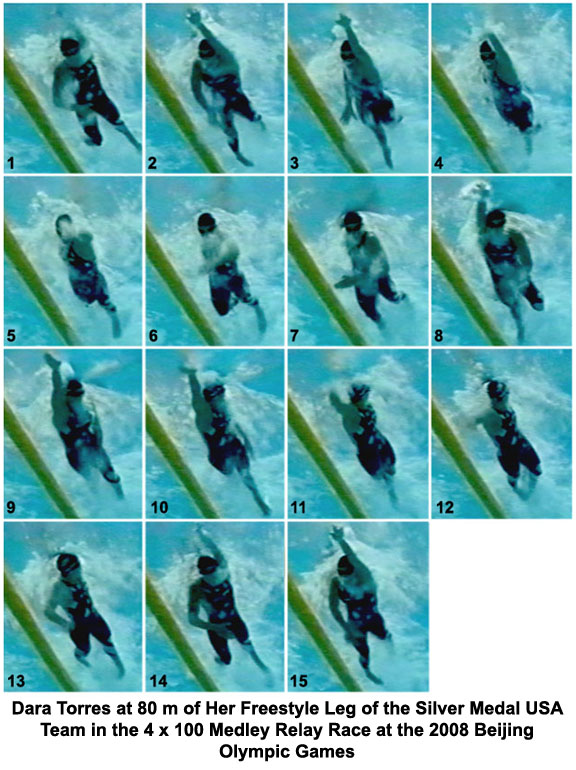HOW CHAMPIONS DO IT
Researched, produced, and prepared by Brent S. Rushall,
Ph.D., R.Psy.

DARA TORRES AT 80 m OF HER FREESTYLE LEG OF THE SILVER MEDAL USA TEAM IN THE 4 X 100 MEDLEY RELAY RACE AT THE 2008 BEIJING OLYMPIC GAMES
Dara Torres swam this 100 m leg of the relay in 52.27 seconds, the fastest leg of both 4 x 100 m relay finals in the Olympic Games. The time between each frame is not known because the frames were extracted from a slow motion video capture. The time between each frame is consistent.
This stroke analysis includes a moving sequence in real time, a moving sequence where each frame is displayed for .5 of a second, and still frames.
The following image sequence is in real time. It will play through 10 times and then stop. To repeat the sequence, click the browser's "refresh" or "reload" button.

The following image sequence shows each frame for half a second. It will play through 10 times and then stop. To repeat the sequence, click the browser's "refresh" or "reload" button.

At the end of the following narrative, each frame is illustrated in detail in a sequential collage.
Notable Features
- Dara Torres swims a very long stroke, best exhibited in Frames #3 and #10. The length of her stroke was exhibited at the USA Trials when in the 50 m final she swam 17 strokes to every 20 strokes of Jessica Hardy who placed second. It seems that the significant crawl stroke female swimmers in this Olympic Games have emphasized the most important part of the propulsive stroke – the back end. In both arm strokes, Dara Torres pushes to the very end of the stroke when only the hand is capable of developing propulsion. [This does not mean that the arm should straighten, just that the focus on the less important "front quadrant" has been a bogus direction to the detriment of building momentum as long as is economically advisable in a full stroke.]
- The swimmer pulls decidedly under her body – or alternately, she swims "over her work". That is desirable because it means most of the propulsive forces translate into forward progress. To aid the positioning of the pull under the swimmer, the amount of shoulder roll is pronounced. Frames #4 and #11 show body rotation to each side of at least 60°. That amount of rotation positions more of the arm under the swimmer than could be achieved with less rotation. To facilitate the high levels of rotation, during the pull the face looks to each side rather than being fixed with the eyes focused on the pool bottom. An added benefit of the shoulder rotation is that it ensures that all the muscles of the internal and external rotator groups are involved in powering upper arm abduction and adduction. That is likely to be a major factor in contributing to the exceptional performances of Dara Torres.
- Between each arm stroke, there is little to no inertial lag. In Frame #4, the left wrist (and possibly the elbow) bends as the right arm exits the water. A somewhat similar wrist and elbow bend occurs in Frame #11 as the left arm exits. The absence of any catch-up" means the swimmer is continually propelling herself and negative acceleration between strokes is minimized.
- The power of the full arm stroke is exhibited in the amount of turbulent water that follows the propelling arm when the whole arm applies effective force (Frames #7, #8, and #9 for the left arm; and Frames #12, #13, and #2 for the right arm).
- The head down position throughout the stroke contributes to very impressive streamlining.
- The kick is not propulsive. Frames #2, #5, #8, and #10 show foot positions and drag force turbulence that actually would slow the swimmer. Drag off the front of the leg on the rise preparatory to kicking is shown clearly in Frames #2 and #3, and #13 and #15.
Dara Torres is one of the top two female sprinters in the world at the age of 41 years. Her performance is the result of an exceptionally powerful and efficient stroke. Her length of effective arm propulsion, streamlining, and body roll that enables muscles to be used fully to produce force, are worthy of emulation.

Return to Table of Contents for this section.






